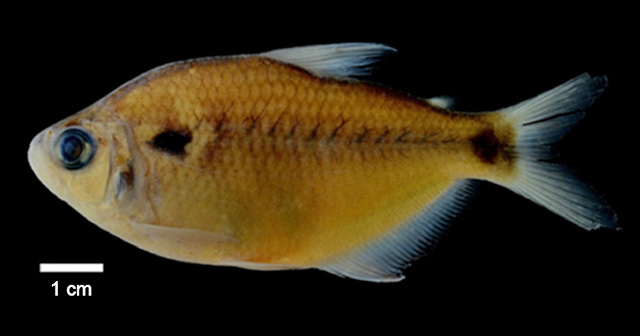| Characidae (Characins; tetras), subfamily: Stethaprioninae |
| 7.74 cm SL (male/unsexed) |
|
benthopelagic; freshwater |
| South America: tributaries of the Río Cascajales, in Río La Colorada basin, Río
Magdalena system in Colombia. |
|
Dorsal soft rays (total): 10-11; Anal soft rays: 31-33; Vertebrae: 35-37. Distinguished from other congeners by having the following characters: predorsal scale series regular with 13 scales; maxilla with six teeth; nine scale rows between dorsal-fin origin and lateral line; and snout length 14.9-25.3 % of head length. Can be separated easily from other characins (except for Astyanacinus orthodus) by its coloration pattern consisting of two humeral spots, midlateral stripe formed by anteriorly oriented chevron bars, and horizontally oriented oval-shaped caudal spot that continues over median caudal rays and never reaches a vertical through the last anal-fin ray base. Differs also from species of Astyanax by the combination of 6 teeth in maxilla, 13 scales in a regular predorsal series, 36-39 lateral line scales, 9 scale rows above and 7 scale rows below the lateral line, ii-iii 28-30 anal fin rays, and a maximum body depth 35.4-43.2% of SL (Ref. 91755).
Description: |
|
|
Data deficient (DD); Date assessed: 06 October 2014 Ref. (130435)
|
| harmless |
|
Source and more info: www.fishbase.org. For personal, classroom, and other internal use only. Not for publication.

